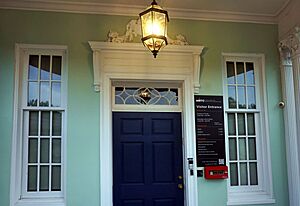Holocaust Memorial and Tolerance Center of Nassau County facts for kids
The Holocaust Memorial and Tolerance Center of Nassau County (HMTC) is a special place in Glen Cove, New York. It is a museum and a center that teaches about the Holocaust. It also helps people learn about being tolerant and understanding towards others.
The HMTC is located inside an old mansion called "Welwyn." This mansion is now part of Welwyn Preserve County Park. The center also has a beautiful garden next to it. This garden was designed by the famous Olmsted Brothers. The museum is open on weekdays from 10:00 AM to 4:30 PM. On Saturdays and Sundays, it is open from 12:00 PM to 4:00 PM.
Contents
History of the HMTC
The Welwyn Mansion's Story
The museum is housed in a grand building called "Welwyn." This mansion was built in 1906. It was designed by the architects Delano & Aldrich. Welwyn was once the home of Harold Irving Pratt, a wealthy oil industrialist. He was also known for his generous donations to good causes.
Harold Pratt was born in 1877 and passed away in Glen Cove in 1939. His wife, Harriet Barnes Pratt, loved nature and gardens. When she passed away in 1969, she left the Welwyn estate to Nassau County. For about 30 years, the mansion was not well cared for. For ten of those years, it was used to train staff for the Nassau Sheriff's Department.
Creating the HMTC
The idea for the Holocaust Memorial and Educational Center of Nassau County began in 1989. Thomas S. Gulotta, who was the Nassau County Executive, wanted to create a permanent memorial. He had asked a special commission in 1988 to find a home for a museum and learning center.
Leaders from different religions worked together on this project. Rabbi Myron M. Fenster and Bishop John R. McGann were key leaders. Many other important people also helped. These included Monsignor Donald M. Beckmann and lawyer Isaac Blachor. Mr. Simon Zareh and Mr. Stanley Garczynski also played important roles. Mr. Garczynski was a Polish Catholic who survived Auschwitz.
Mr. Boris Chartan, who survived a work camp, became the first Chairman of the Center's committee in 1992. Mr. Irving Roth, who survived both Auschwitz and Buchenwald, helped lead the dedication ceremony. The center officially opened in 1994.
County Executive Tom Gulotta was praised for making the center a reality. Many people believed in the center's mission. They wanted to teach about the Holocaust and fight against hatred. Mr. Roth explained that if many different groups share their stories of suffering, it makes the message stronger. Mr. Chartan wanted the museum to teach about all kinds of hatred, like racism and bullying.
The Louis Posner Memorial Library
In 1996, the Louis Posner Memorial Library opened at the museum. This library has the largest collection of books on Long Island about the Holocaust. It also has books about genocide, fighting discrimination, and other forms of hatred.
The Children's Butterfly Garden
Harriet Pratt, who lived in the mansion before it became a museum, loved plants and nature. She helped create the beautiful garden next to the mansion. She also had many greenhouses on the property. After she passed away, the garden became overgrown and damaged.
However, after the museum opened, the garden was restored. It became a magnificent butterfly garden. In 2003, this garden was dedicated to the over one million children who were murdered during the Holocaust. It serves as a peaceful and meaningful place for visitors.





